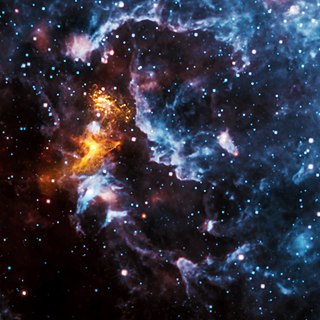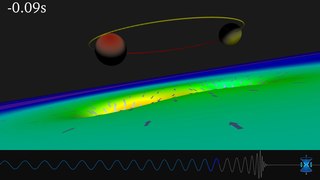
A neutron star is the collapsed core of a massive supergiant star, which had a total mass of between 10 and 25 solar masses, possibly more if the star was especially metal-rich. Except for black holes and some hypothetical objects, neutron stars are the smallest and densest currently known class of stellar objects. Neutron stars have a radius on the order of 10 kilometres (6 mi) and a mass of about 1.4 solar masses. They result from the supernova explosion of a massive star, combined with gravitational collapse, that compresses the core past white dwarf star density to that of atomic nuclei.

Einstein@Home is a volunteer computing project that searches for signals from spinning neutron stars in data from gravitational-wave detectors, from large radio telescopes, and from a gamma-ray telescope. Neutron stars are detected by their pulsed radio and gamma-ray emission as radio and/or gamma-ray pulsars. They also might be observable as continuous gravitational wave sources if they are rapidly spinning and non-axisymmetrically deformed. The project was officially launched on 19 February 2005 as part of the American Physical Society's contribution to the World Year of Physics 2005 event.

A pulsar is a highly magnetized rotating neutron star that emits beams of electromagnetic radiation out of its magnetic poles. This radiation can be observed only when a beam of emission is pointing toward Earth, and is responsible for the pulsed appearance of emission. Neutron stars are very dense and have short, regular rotational periods. This produces a very precise interval between pulses that ranges from milliseconds to seconds for an individual pulsar. Pulsars are one of the candidates for the source of ultra-high-energy cosmic rays.

A millisecond pulsar (MSP) is a pulsar with a rotational period less than about 10 milliseconds. Millisecond pulsars have been detected in radio, X-ray, and gamma ray portions of the electromagnetic spectrum. The leading theory for the origin of millisecond pulsars is that they are old, rapidly rotating neutron stars that have been spun up or "recycled" through accretion of matter from a companion star in a close binary system. For this reason, millisecond pulsars are sometimes called recycled pulsars.

PSR J0737−3039 is the first known double pulsar. It consists of two neutron stars emitting electromagnetic waves in the radio wavelength in a relativistic binary system. The two pulsars are known as PSR J0737−3039A and PSR J0737−3039B. It was discovered in 2003 at Australia's Parkes Observatory by an international team led by the Italian radio astronomer Marta Burgay during a high-latitude pulsar survey.
Rotating radio transients (RRATs) are sources of short, moderately bright, radio pulses, which were first discovered in 2006. RRATs are thought to be pulsars, i.e. rotating magnetised neutron stars which emit more sporadically and/or with higher pulse-to-pulse variability than the bulk of the known pulsars. The working definition of what a RRAT is, is a pulsar which is more easily discoverable in a search for bright single pulses, as opposed to in Fourier domain searches so that 'RRAT' is little more than a label and does not represent a distinct class of objects from pulsars. As of March 2015 over 100 have been reported.

The Virgo interferometer is a large interferometer designed to detect gravitational waves predicted by the general theory of relativity. Virgo is a Michelson interferometer that is isolated from external disturbances: its mirrors and instrumentation are suspended and its laser beam operates in a vacuum. The instrument's two arms are three kilometres long and located in Santo Stefano a Macerata, near the city of Pisa, Italy.

Gravitational waves are waves of the intensity of gravity generated by the accelerated masses of an orbital binary system that propagate as waves outward from their source at the speed of light. They were first proposed by Oliver Heaviside in 1893 and then later by Henri Poincaré in 1905 as waves similar to electromagnetic waves but the gravitational equivalent. Gravitational waves were later predicted in 1916 by Albert Einstein on the basis of his general theory of relativity as ripples in spacetime. Later he refused to accept gravitational waves. Gravitational waves transport energy as gravitational radiation, a form of radiant energy similar to electromagnetic radiation. Newton's law of universal gravitation, part of classical mechanics, does not provide for their existence, since that law is predicated on the assumption that physical interactions propagate instantaneously – showing one of the ways the methods of Newtonian physics are unable to explain phenomena associated with relativity.

A gravitational-wave detector is any device designed to measure tiny distortions of spacetime called gravitational waves. Since the 1960s, various kinds of gravitational-wave detectors have been built and constantly improved. The present-day generation of laser interferometers has reached the necessary sensitivity to detect gravitational waves from astronomical sources, thus forming the primary tool of gravitational-wave astronomy.

Gravitational-wave astronomy is an emerging branch of observational astronomy which aims to use gravitational waves to collect observational data about objects such as neutron stars and black holes, events such as supernovae, and processes including those of the early universe shortly after the Big Bang.
Einstein Telescope (ET) or Einstein Observatory, is a proposed third-generation ground-based gravitational wave detector, currently under study by some institutions in the European Union. It will be able to test Einstein's general theory of relativity in strong field conditions and realize precision gravitational wave astronomy.

PSR B1937+21 is a pulsar located in the constellation Vulpecula a few degrees in the sky away from the first discovered pulsar, PSR B1919+21. The name PSR B1937+21 is derived from the word "pulsar" and the declination and right ascension at which it is located, with the "B" indicating that the coordinates are for the 1950.0 epoch. PSR B1937+21 was discovered in 1982 by Don Backer, Shri Kulkarni, Carl Heiles, Michael Davis, and Miller Goss.
A pulsar timing array (PTA) is a set of pulsars which is analysed to search for correlated signatures in the pulse arrival times. There are many applications for pulsar timing arrays. The best known is the use of an array of millisecond pulsars to detect and analyse gravitational waves. Such a detection would result from a detailed investigation of the correlation between arrival times of pulses emitted by the millisecond pulsars as a function of the pulsars' angular separations.
PSR J1614–2230 is a pulsar in a binary system with a white dwarf in the constellation Scorpius. It was discovered in 2006 with the Parkes telescope in a survey of unidentified gamma ray sources in the Energetic Gamma Ray Experiment Telescope catalog. PSR J1614–2230 is a millisecond pulsar, a type of neutron star, that spins on its axis roughly 317 times per second, corresponding to a period of 3.15 milliseconds. Like all pulsars, it emits radiation in a beam, similar to a lighthouse. Emission from PSR J1614–2230 is observed as pulses at the spin period of PSR J1614–2230. The pulsed nature of its emission allows for the arrival of individual pulses to be timed. By measuring the arrival time of pulses, astronomers observed the delay of pulse arrivals from PSR J1614–2230 when it was passing behind its companion from the vantage point of Earth. By measuring this delay, known as the Shapiro delay, astronomers determined the mass of PSR J1614–2230 and its companion. The team performing the observations found that the mass of PSR J1614–2230 is 1.97 ± 0.04 M☉. This mass made PSR J1614–2230 the most massive known neutron star at the time of discovery, and rules out many neutron star equations of state that include exotic matter such as hyperons and kaon condensates.
The North American Nanohertz Observatory for Gravitational Waves (NANOGrav) is a consortium of astronomers who share a common goal of detecting gravitational waves via regular observations of an ensemble of millisecond pulsars using the Green Bank and Arecibo radio telescopes. This project is being carried out in collaboration with international partners in the Parkes Pulsar Timing Array in Australia and the European Pulsar Timing Array as part of the International Pulsar Timing Array.
The International Pulsar Timing Array (IPTA) is a multi-institutional, multi-telescope collaboration comprising the European Pulsar Timing Array (EPTA), the North American Nanohertz Observatory for Gravitational Waves (NANOGrav), the Parkes Pulsar Timing Array (PPTA) in Australia, and the Indian Pulsar Timing Array Project (InPTA). The goal of the IPTA is to detect ultra-low-frequency gravitational waves, such as from mergers of supermassive black holes, using an array of approximately 30 pulsars. This goal is shared by each of the participating institutions, but they have all recognized that their goal will be achieved more quickly by combining their respective efforts and resources.

The Neutron Star Interior Composition ExploreR (NICER) is a NASA telescope on the International Space Station, designed and dedicated to the study of the extraordinary gravitational, electromagnetic, and nuclear physics environments embodied by neutron stars, exploring the exotic states of matter where density and pressure are higher than in atomic nuclei. As part of NASA's Explorer program, NICER enabled rotation-resolved spectroscopy of the thermal and non-thermal emissions of neutron stars in the soft X-ray band with unprecedented sensitivity, probing interior structure, the origins of dynamic phenomena, and the mechanisms that underlie the most powerful cosmic particle accelerators known. NICER achieved these goals by deploying, following the launch, and activation of X-ray timing and spectroscopy instruments. NICER was selected by NASA to proceed to formulation phase in April 2013.

PSR J0348+0432 is a pulsar–white dwarf binary system in the constellation Taurus. It was discovered in 2007 with the National Radio Astronomy Observatory's Robert C. Byrd Green Bank Telescope in a drift-scan survey.

The first direct observation of gravitational waves was made on 14 September 2015 and was announced by the LIGO and Virgo collaborations on 11 February 2016. Previously, gravitational waves had been inferred only indirectly, via their effect on the timing of pulsars in binary star systems. The waveform, detected by both LIGO observatories, matched the predictions of general relativity for a gravitational wave emanating from the inward spiral and merger of a pair of black holes of around 36 and 29 solar masses and the subsequent "ringdown" of the single resulting black hole. The signal was named GW150914. It was also the first observation of a binary black hole merger, demonstrating both the existence of binary stellar-mass black hole systems and the fact that such mergers could occur within the current age of the universe.

GW 170817 was a gravitational wave (GW) signal observed by the LIGO and Virgo detectors on 17 August 2017, originating from the shell elliptical galaxy NGC 4993. The signal was produced by the last minutes of a binary pair of neutron stars' inspiral process, ending with a merger. It is the first GW observation that has been confirmed by non-gravitational means. Unlike the five previous GW detections, which were of merging black holes not expected to produce a detectable electromagnetic signal, the aftermath of this merger was also seen by 70 observatories on 7 continents and in space, across the electromagnetic spectrum, marking a significant breakthrough for multi-messenger astronomy. The discovery and subsequent observations of GW 170817 were given the Breakthrough of the Year award for 2017 by the journal Science.















